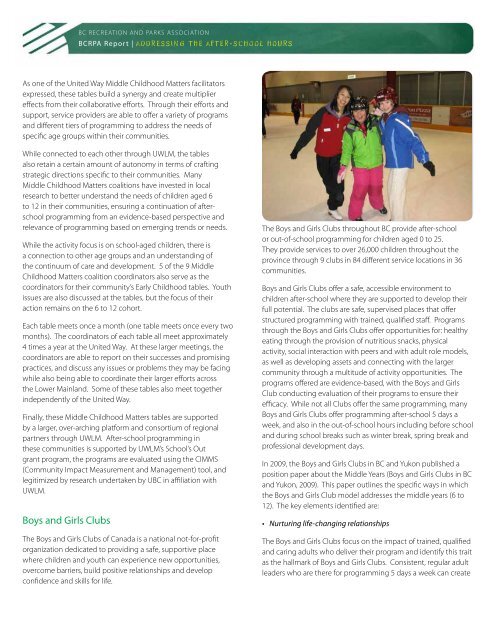BCRPA Report: Addressing the after-school hours - Middle ...
BCRPA Report: Addressing the after-school hours - Middle ...
BCRPA Report: Addressing the after-school hours - Middle ...
Create successful ePaper yourself
Turn your PDF publications into a flip-book with our unique Google optimized e-Paper software.
22 | www.bcrpa.bc.ca<br />
BC RECREATION AND PARKS ASSOCIATION<br />
<strong>BCRPA</strong> <strong>Report</strong> |<br />
As one of <strong>the</strong> United Way <strong>Middle</strong> Childhood Matters facilitators<br />
expressed, <strong>the</strong>se tables build a synergy and create multiplier<br />
effects from <strong>the</strong>ir collaborative efforts. Through <strong>the</strong>ir efforts and<br />
support, service providers are able to offer a variety of programs<br />
and different tiers of programming to address <strong>the</strong> needs of<br />
specific age groups within <strong>the</strong>ir communities.<br />
While connected to each o<strong>the</strong>r through UWLM, <strong>the</strong> tables<br />
also retain a certain amount of autonomy in terms of crafting<br />
strategic directions specific to <strong>the</strong>ir communities. Many<br />
<strong>Middle</strong> Childhood Matters coalitions have invested in local<br />
research to better understand <strong>the</strong> needs of children aged 6<br />
to 12 in <strong>the</strong>ir communities, ensuring a continuation of <strong>after</strong><strong>school</strong><br />
programming from an evidence-based perspective and<br />
relevance of programming based on emerging trends or needs.<br />
While <strong>the</strong> activity focus is on <strong>school</strong>-aged children, <strong>the</strong>re is<br />
a connection to o<strong>the</strong>r age groups and an understanding of<br />
<strong>the</strong> continuum of care and development. 5 of <strong>the</strong> 9 <strong>Middle</strong><br />
Childhood Matters coalition coordinators also serve as <strong>the</strong><br />
coordinators for <strong>the</strong>ir community’s Early Childhood tables. Youth<br />
issues are also discussed at <strong>the</strong> tables, but <strong>the</strong> focus of <strong>the</strong>ir<br />
action remains on <strong>the</strong> 6 to 12 cohort.<br />
Each table meets once a month (one table meets once every two<br />
months). The coordinators of each table all meet approximately<br />
4 times a year at <strong>the</strong> United Way. At <strong>the</strong>se larger meetings, <strong>the</strong><br />
coordinators are able to report on <strong>the</strong>ir successes and promising<br />
practices, and discuss any issues or problems <strong>the</strong>y may be facing<br />
while also being able to coordinate <strong>the</strong>ir larger efforts across<br />
<strong>the</strong> Lower Mainland. Some of <strong>the</strong>se tables also meet toge<strong>the</strong>r<br />
independently of <strong>the</strong> United Way.<br />
Finally, <strong>the</strong>se <strong>Middle</strong> Childhood Matters tables are supported<br />
by a larger, over-arching platform and consortium of regional<br />
partners through UWLM. After-<strong>school</strong> programming in<br />
<strong>the</strong>se communities is supported by UWLM’s School’s Out<br />
grant program, <strong>the</strong> programs are evaluated using <strong>the</strong> CIMMS<br />
(Community Impact Measurement and Management) tool, and<br />
legitimized by research undertaken by UBC in affiliation with<br />
UWLM.<br />
Boys and Girls Clubs<br />
The Boys and Girls Clubs of Canada is a national not-for-profit<br />
organization dedicated to providing a safe, supportive place<br />
where children and youth can experience new opportunities,<br />
overcome barriers, build positive relationships and develop<br />
confidence and skills for life.<br />
The Boys and Girls Clubs throughout BC provide <strong>after</strong>-<strong>school</strong><br />
or out-of-<strong>school</strong> programming for children aged 0 to 25.<br />
They provide services to over 26,000 children throughout <strong>the</strong><br />
province through 9 clubs in 84 different service locations in 36<br />
communities.<br />
Boys and Girls Clubs offer a safe, accessible environment to<br />
children <strong>after</strong>-<strong>school</strong> where <strong>the</strong>y are supported to develop <strong>the</strong>ir<br />
full potential. The clubs are safe, supervised places that offer<br />
structured programming with trained, qualified staff. Programs<br />
through <strong>the</strong> Boys and Girls Clubs offer opportunities for: healthy<br />
eating through <strong>the</strong> provision of nutritious snacks, physical<br />
activity, social interaction with peers and with adult role models,<br />
as well as developing assets and connecting with <strong>the</strong> larger<br />
community through a multitude of activity opportunities. The<br />
programs offered are evidence-based, with <strong>the</strong> Boys and Girls<br />
Club conducting evaluation of <strong>the</strong>ir programs to ensure <strong>the</strong>ir<br />
efficacy. While not all Clubs offer <strong>the</strong> same programming, many<br />
Boys and Girls Clubs offer programming <strong>after</strong>-<strong>school</strong> 5 days a<br />
week, and also in <strong>the</strong> out-of-<strong>school</strong> <strong>hours</strong> including before <strong>school</strong><br />
and during <strong>school</strong> breaks such as winter break, spring break and<br />
professional development days.<br />
In 2009, <strong>the</strong> Boys and Girls Clubs in BC and Yukon published a<br />
position paper about <strong>the</strong> <strong>Middle</strong> Years (Boys and Girls Clubs in BC<br />
and Yukon, 2009). This paper outlines <strong>the</strong> specific ways in which<br />
<strong>the</strong> Boys and Girls Club model addresses <strong>the</strong> middle years (6 to<br />
12). The key elements identified are:<br />
• Nurturing life-changing relationships<br />
The Boys and Girls Clubs focus on <strong>the</strong> impact of trained, qualified<br />
and caring adults who deliver <strong>the</strong>ir program and identify this trait<br />
as <strong>the</strong> hallmark of Boys and Girls Clubs. Consistent, regular adult<br />
leaders who are <strong>the</strong>re for programming 5 days a week can create


